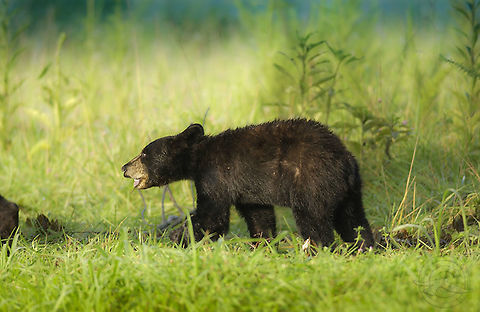
Distribution
Historically, black bears occupied the majority of North America's forested regions. Today, they are primarily limited to sparsely settled, forested areas.Black bears currently inhabit much of their original Canadian range, though they do not occur in the southern farmlands of Alberta, Saskatchewan, and Manitoba. They have been extinct in Prince Edward Island since 1937. The total Canadian black bear population is between 396,000 and 476,000, based on surveys taken in the mid 1990s in seven Canadian provinces, though this estimate excludes black bear populations in New Brunswick, Northwest Territories, Nova Scotia, and Saskatchewan. All provinces indicated stable populations of black bears over the last decade.
The current range of black bears in the United States is constant throughout most of the northeast, the northern midwest, the Rocky mountain region, the west coast and Alaska. However it becomes increasingly fragmented or absent in other regions.

Status
The American black bear is listed by the IUCN as Least Concern, due to the species' widespread distribution and a large global population estimated to be twice that of all other bear species combined.Along with the brown bear, it is one of only two of the eight modern bear species not considered globally threatened with extinction by the IUCN. American black bears often mark trees using their teeth and claws as a form of communication with other bears, a behavior common to many species of bears.

Behavior
In his "Great Bear Almanac", Gary Brown lists 20 different sounds in eight different contexts. Sounds expressing aggression include growls, woofs, snorts, bellows and roars. Sounds expressing contentment include mumbles, squeaks and pants.American black bears tend to be territorial and non-gregarious in nature. They mark their territories by rubbing their bodies against trees and clawing at the bark. Black bears are excellent and strong swimmers, doing so for pleasure and to feed. Black bears climb regularly to feed, escape enemies or to hibernate. Their arboreal abilities tend to decline with age. Adult black bears are mostly nocturnal, but juveniles are often active in daytime.

Reproduction
Sows usually produce their first litter at the age of 3–5 years. Sows living in urban areas tend to get pregnant at younger ages. The breeding period usually occurs in the June–July period, though it can extend to August in the species' northern range.The breeding period lasts for 2–3 weeks. Sows tend to be short tempered with their mates after copulating. The gestation period lasts 235 days, and litters are usually born in late January to early February. Litters usually consist of two cubs, though litters of 6 have been recorded.
At birth, cubs weigh 10–16 ounces, and measure 8 inches in length. They are born with fine, gray, downlike hair, and their hind quarters are underdeveloped. They typically open their eyes after 28–40 days, and begin walking after 5 weeks.
Cubs are dependent on their mother's milk for 30 weeks, and will reach independence at 16–18 months. At the age of six weeks, they attain 2 lb, by 8 weeks they reach 5 lb and by the age of 6 months they weigh 40–60 lb. They reach sexual maturity at the age of three years, and attain their full growth at 5 years.
The average lifespan in the wild is 18 years. The record age of a wild specimen was 31 years, while that in captivity was 44 years.

Food
Up to 85% of the black bear's diet consists of vegetation, though they tend to dig less than brown bears, eating far fewer roots, bulbs, corms and tubers than the latter species. Young shoots from trees and shrubs during the spring period are important to black bears emerging from hibernation, as they assist in rebuilding muscle and strengthening the skeleton and are often the only digestible foods available at that time.Berries, fruits, grasses, nuts and buds are often eaten. During this period, they may also raid the nut caches of squirrels. Black bears are fond of honey, and will gnaw through trees if hives are too deeply set into the trunks for them to reach them with their paws. Once the hive is breached, black bears will scrape the honeycombs together with their paws and eat them, regardless of stings from the bees.
The majority of the black bear's animal diet consists of insects such as bees, yellow-jackets, ants and their larvae. Black bears will fish for salmon during the night, as their black fur is easily spotted by salmon in the daytime.
They will also prey on mule and white-tailed deer fawns in certain areas.

Evolution
Although they all live in North America, American black bears are not closely related to brown bears and polar bears; genetic studies reveal that they split from a common ancestor 5.05 million years ago. Both American and Asiatic black bears are considered sister taxa, and are more closely related to each other than to other species of bear.
Cultural
Black bears feature prominently in the stories of some of America's indigenous peoples. One tale tells of how the black bear was a creation of the Great Spirit, while the grizzly was created by the Evil Spirit. In the mythology of the Haida, Tlingit, Tsimshian people of the Northwest Coast, mankind first learned to respect bears when a girl married the son of black bear Chieftain.In Kwakiutl mythology, black and brown bears became enemies when Grizzly Bear Woman killed Black Bear Woman for being lazy. Black Bear Woman's children, in turn, killed Grizzly Bear Woman's own cubs. The Navajo believed that the Big Black Bear was chief among the bears of the four directions surrounding Sun's house, and would pray to it in order to be granted its protection during raids.
References:
Some text fragments are auto parsed from Wikipedia.